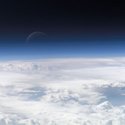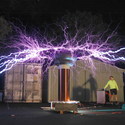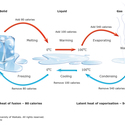Lightning1 is a large-scale natural spark discharge2 that occurs within the atmosphere3 or between the atmosphere and the Earth’s surface. On discharge, a highly electrically conductive plasma4 channel is created within the air, and when current5 flows within this channel, it rapidly heats the air up to about 25,000°C. The lightning channel is an example of terrestrial6 plasma in action.
Seeing lightning
Lightning is visible as a flash of blue-white light. The extremely high temperatures generated heat7 the air molecules8 to a state of incandescence (white hot) such that they emit a vivid white light. At the same time, nitrogen9 gas (the dominant10 gas in the atmosphere) is stimulated to luminesce, producing bright blue-white. The combination of light from luminescence11 and incandescence gives the bolt of lightning its characteristic colour.
Lightning’s partner
Temperatures in the narrow lightning channel reach about 25,000°C. The surrounding air is rapidly heated, causing it to expand violently at a rate faster than the speed of sound, similar to a sonic boom. At about 10 m out from the channel, it becomes an ordinary sound wave called thunder.
Thunder is effectively exploding air, and when heard close to the lightning channel, it consists of one large bang. At about 1 km away, it is heard as a rumble with several loud claps. Distant thunder has a characteristic low-pitched rumbling sound. However, beyond 16 km, thunder is seldom heard.
Conditions needed for lightning to occur
It is the formation and separation of positive and negative electric charges12 within the atmosphere that creates the highly intensive electric field13 needed to support this natural spark discharge that is lightning.
The formation of electric charges in the atmosphere is due mainly to the ionisation of air molecules by cosmic rays14. Cosmic rays are high-energy particles such as protons that originate from outside the solar system15. On colliding with air molecules, they produce a shower of lighter particles, some of which are charged.
Within a thundercloud, the rapid upward and downward movement of water droplets and ice crystals can separate and concentrate these charges. The negative charges accumulate at the bottom part of the cloud and the positive charges towards the top.
Lightning production
As the area of negative charge at the base of the thundercloud builds up, it induces a region of positive charge to develop on the ground below. As a result of this, a potential difference or voltage16 is created across the cloud-to-ground gap. Once the voltage reaches a certain strength, the air between the base of the cloud and the ground develops an electrical conductivity. At first a channel, known as a stepped leader17, is formed. Although invisible to the naked eye, this allows electrons to move from the cloud to the ground.
It is called a stepped leader because it travels in 50 to 100 m sections, with a slight pause in between, to the ground. As it nears the ground, a positively charged streamer18 fires upwards from the ground to connect with it. Streamers are most often initiated from tall objects on the ground.
Once connected, electrons from the cloud can flow to the ground and positive charges can flow from the ground to the cloud. It is this flow of charge that is the visible lightning stroke19.
After the first discharge, it is possible for another leader to form down the channel. Once again, a visible lightning stoke is seen. This can happen 3–4 times in quick succession. All of this happens in a time interval of about 200 milliseconds.
Monitoring lightning
A worldwide lightning location network (WWLLN, pronounced ‘woollen’) was founded in New Zealand in 2003. Working with the collaboration20 of scientists from around the world, the network plots lightning discharge locations seconds after they occur.
Around the world, there are about 45 lightning flashes per second. Apart from generating the characteristic blue-white light, radio wave pulses known as sferics are also produced. The frequent crackles heard when tuned into an AM radio station during a thunderstorm are sferics from the lightning discharges21.
These sferics are registered at the 60 WWLLN receiving stations around the world and provide a near real-time information dataset. This information is made available to scientists via a high-speed internet connection provided by REANNZ (Research and Education Advanced Network New Zealand).
Red sprites
High above thunderstorm clouds at altitudes between 50–90 km, large-scale electrical discharges can occur. These are triggered by thundercloud-to-ground lightning activity. They appear as fleeting, luminous, red-orange flashes and take on a variety of shapes. Unlike ‘hot plasma’ lightning, they are cold plasma forms somewhat similar to the discharges that occur in a fluorescent tube.
It is because of their fleeting nature, lasting mostly for only milliseconds, and ghost-like appearance that the term ‘sprite’ has been used.
Nature of science
The tale of the 100-year hunt for red sprites is a story of how science works. It is a story illustrating that science, rather than knowing all there is to know, stands barely on the threshold of many more discoveries about our complex and fascinating universe22. They were given little more credence than UFO sightings until 1989, when university researchers accidentally captured a red sprite23 on a low-light video camera.
St Elmo’s fire
In the region between a thundercloud and the ground, a very strong electric field24 can be set up. There is a huge potential difference (voltage) established between the negative base of the cloud and the positive ground. When this potential difference reaches a certain value, sharp-pointed ground-based objects are seen to glow, often with a hissing sound.
Because this weather-related occurrence sometimes appeared on ships at sea during thunderstorms, it was given the name ‘St Elmo’s fire’. Saint Elmo is the patron saint of sailors, and in the past, sailors regarded such an event as an omen of bad luck and stormy weather25.
St Elmo’s fire is a bright blue or violet glow due to the formation of luminous plasma. It appears like fire in some circumstances coming from sharply pointed objects such as masts, spires, lightning rods and even on aircraft wings.
Related content
Explore the basics of static electricity and electrical charge26 and electrons, insulators and conductors.
Help your students understand more about lightening with the Viewing and monitoring lightning activity.
Useful links
NASA SciJinks website on lightning with easy-to-read information and good animations.
Lightning article from New World Encyclopedia website that includes information on the history of lightning research including a theory27 called runaway breakdown, a hypothesises that cosmic rays28 trigger the process.
Information on ‘transient luminous events’ produced by large thunderstorms in the upper atmosphere.
Up-to-date information on worldwide lightning strikes from WWLLN.
- lightning: A large-scale natural spark discharge, visible as a flash of blue-white light, that occurs within the atmosphere or between the atmosphere and the Earth’s surface. The lightning channel consists of extremely high-temperature plasma.
- discharge: 1. The conversion of chemical energy to electric energy. 2. A flowing out or pouring out.
- atmosphere: 1. The layer of gas around the Earth. 2. (atm) A non-SI unit of pressure equivalent to 101.325 kPa.
- plasma: 1. The fourth state of matter – a gas that is ionised and consists of positive and negative ions (or particles), with no overall charge. It is affected by magnetic fields and has high electrical conductivity. 2. The colourless or pale yellow liquid in blood and lymph.
- current: The flow of electric charge through a conductor.
- terrestrial: Belonging or from the land. This term is often used to describe plants and animals, meaning they live on the land.
- heat energy (heat): Heat energy: the transfer of energy in materials from the random movement of the particles in that material. The greater the random movement of particles the more heat energy the material has. Temperature is a measure of the heat energy of a material.
Heat: the flow of energy from a warm object to a cooler object. - molecule: Two or more atoms bonded together. The molecule of an element has all its atoms the same. The molecule of a compound has two or more different atoms.
- nitrogen: A non-metal – symbol N, atomic number 7. Nitrogen is essential for life. It is a component of many molecules that make up cells, including DNA and proteins.
- dominant: An allele that is expressed if it is present.
- luminescence: A process in which energy stored in a material is given off as light when suitably stimulated.
- electric charge: An excess of electrons on an object gives it a negative charge whereas a deficiency of electrons gives it a positive charge. Protons carry a positive charge and electrons carry a negative charge. Ions carry a positive or negative charge.
- electric field: Any region where a charged object experiences an electric force.
- cosmic ray: High-energy rays of charged particles coming from Space.
- Solar System: The Sun and objects in orbit around it, including the planets and their moons, asteroids and comets. The Sun is a star like many others in the galaxy.
- voltage: The potential difference (PD) between two points in a circuit. It measures the potential of the electrons to flow between two points. The higher the PD, the greater the electron flow. PD is sometimes thought of as electrical pressure.
- stepped leader: A faint luminous light that branches down from a thunderstorm cloud base towards the ground before a lightning flash. It is seen to rapidly grow towards the ground in 50 m steps, and as it nears the ground, a positively charged streamer fires upwards to connect with it.
- streamer: An upwardly propagating positively charged channel that meets a stepped leader to form a lightning bolt.
- stroke: 1. When part of the brain is damaged due to its blood supply being reduced or stopped. 2. A lightning flash is an event made up of a set of strokes.
- collaboration: Working together with a common purpose.
- discharge: 1. The conversion of chemical energy to electric energy. 2. A flowing out or pouring out.
- universe: All matter and energy, including the Earth, the galaxies and the contents of intergalactic space, regarded as a whole.
- red sprite: A large-scale electrical discharge that occurs between the top of a thunderstorm cloud and the upper atmosphere. Triggered by lightning discharges between the cloud and the ground, they have a fleeting appearance as red luminous flashes.
- electric field: Any region where a charged object experiences an electric force.
- weather: Daily or short-term conditions like temperature, cloud cover, precipitation and wind affecting a certain area.
- electric charge: An excess of electrons on an object gives it a negative charge whereas a deficiency of electrons gives it a positive charge. Protons carry a positive charge and electrons carry a negative charge. Ions carry a positive or negative charge.
- theory: To scientists, a theory provides a coherent explanation that holds true for a large number of facts and observations about the natural world. It has to be internally consistent, based upon evidence, tested against a wide range of phenomena and demonstrate problem solving.
- cosmic ray: High-energy rays of charged particles coming from Space.







